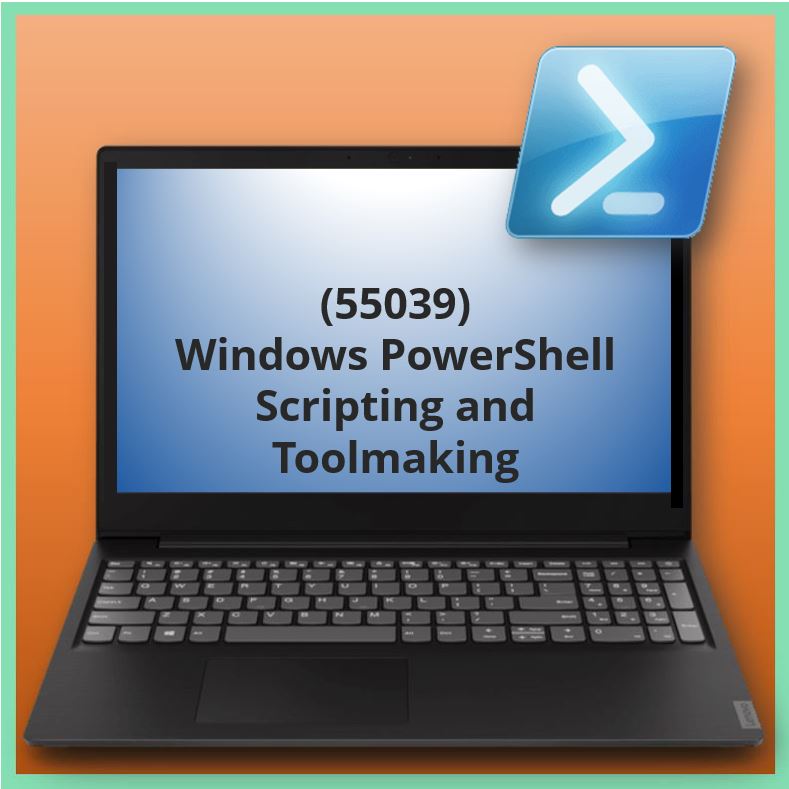Aangeboden leervormen

Windows PowerShell Scripting and Toolmaking (55039)
Course Description
This course is intended for IT Professionals who have a working knowledge of Windows PowerShell 3.0 techniques and technologies, and who want to build reusable tools by using Windows PowerShell 3.0. Students of this course may administer a wide variety of server and client products and technologies that offer Windows PowerShell integration, including Microsoft Exchange Server, Microsoft Windows Active Directory Domain Services, Microsoft SharePoint Server, and more. This course focuses on the Windows PowerShell scripting language, and on the concepts and techniques needed to produce reusable, professional tools.
At Course Completion
After completing this course, students will be able to:
· Design tools, including input requirements, output requirements, and functional requirements.
· Write tools, including scripting, parameterizing commands, and providing verbose output.
· Debug tools and provide error handling within tools.
· Combine tools into script and manifest modules.
· Create custom formatting views.
· Create tools that are consistent in naming and operation with native Windows PowerShell tools

Voor wie
This course is intended for administrators that have little or no programming experience, but who have a working knowledge of Windows PowerShell and who are able to use Windows PowerShell to run complex, interactive commands.
Programma
Module 1: Preparing for Scripting
This module explains how to prepare the environment for scripting, and provides refresher and background information for scripting.
Lessons
· Securing the Scripting Environment
· Understanding Variables and Operators
· Understanding Scripting Constructs and Scope
After completing this module, students will be able to:
· Describe and set the execution policy.
· Run Windows PowerShell scripts.
· Use variables and operators.
· Describe and use scripting constructs.
· Describe the operation of Windows PowerShell scope.
Module 2: Parameterizing a Command
This module explains how to start with an existing command and parameterize it to create a reusable tool.
Lessons
· Designing Parameters
· Implementing Parameters
Lab : Parameterizing a Command
· Identify changeable values
· Declare parameters
· Use parameters in place of changeable values
· Test the script
After completing this module, students will be able to:
· Evolve a command into a parameterized script.
Module 3: Creating a Script Module
This module explains how to turn a basic script into a script module that can be distributed, loaded, and unloaded in Windows PowerShell.
Lessons
· Designing Script Modules
· Implementing Script Modules
Lab : Creating a Script Module
· Creating a Script Module
· Saving the script module
· Adding a module-level variable
· Controlling module member visibility
· Testing the script module
After completing this module, students will be able to:
· Create a script module based upon an existing script or function.
Module 4: Handling Errors
This module explains how to trap and handle errors within a script module.
Lessons
· Designing Error Handling
· Implementing Error Handling
Lab : Handling Errors
· Using the Try…Catch Construct
· Handling Command Errors
· Handling Non-Command Errors
· Logging Errors to a File
· Displaying Warning Messages
After completing this module, students will be able to:
· Describe and use the Try…Catch construct.
· Handle command errors.
· Handle non-command errors.
· Log errors to a file.
· Display warning messages.
Module 5: Writing Commands that Use Pipeline Input and Output
This module explains how to write commands that integrate with the Windows PowerShell pipeline. Students will create commands that produce pipeline output and that accept pipeline input.
Lessons
· Understanding Pipeline Parameter Binding
· Implementing Pipeline Parameter Input
· Implementing Pipeline Parameter Input
Lab : Writing Commands that Use Pipeline Inout and Output
· Adding Pipeline Input Capability to Parameters
· Working with Pipeline Input
· Creating Custom Output Objects
· Outputting Objects to the Pipeline
After completing this module, students will be able to:
· Create commands that accept pipeline input.
· Create commands that consolidate multiple data sources into Windows PowerShell pipeline output.
Module 6: Creating Hierarchical Command Output
This module explains how to create, and use, object-oriented output that includes object hierarchies.
Lessons
· Designing Complex Command Output
· Implementing Complex Command Output
· Using Object Hierarchies
Lab : Creating Hierarchical Command Output
· Retrieving and Enumerating Data
· Creating Child Objects
· Creating the Parent Object
· Displaying and Object Hierarchy
· Persisting an Object Hierarchy
After completing this module, students will be able to:
· Create hierarchical, object-oriented command output.
· Use hierarchical, object—oriented command output.
Module 7: Debugging Scripts
This module explains Windows PowerShell techniques used to debug scripts, and provides students with opportunities to practice debugging skills.
Lessons
· Designing Scripts for Debugging
· Implementing Script Debugging
Lab : Debugging Scripts
· Using Write-Debug
· Using PSBreakpoints
After completing this module, students will be able to:
· Debug scripts by using Write-Debug.
· Debug scripts by using PSBreakpoints.
Module 8: Customizing Default Formatting
This module explain how to create a custom formatting view that can be added to a script module.
Lessons
· Designing Formatting
· Implementing Custom Formatting
Lab : Customizing Default Formatting
· Adding a Custom Type Name to an Object
· Creating a DefaultDisplayPropertySet Type Extension
· Creating a Custom View
· Adding Type Extensions and Views to Modules and Creating a Module Manifest
After completing this module, students will be able to:
· Create custom type extensions.
· Create custom views.
Module 9: Adding Advanced Parameter Attributes and Command Documentation
This module explains how to declare parameter aliases, help messages, and input validation. It also explains how to implement switch parameters, how to add support for the –WhatIf and –Confirm parameters, and how to add comment-based help to a command.
Lessons
· Implementing Advanced Parameter Attribtues
· Implementing Help Documentation
Lab : Adding Advanced Parameter Attributes and Command Documentation
· Defining Aliases and Help Messages
· Defining Parameter Validation
· Adding Comment-Based Help
· Writing a Command that Uses –Confirm and -WhatIf
After completing this module, students will be able to:
· Add advanced parameter attributes, including aliases and validation.
· Create comment-based documentation for commands.
· Write commands that use –WhatIf and –Confirm parameters.
Module 10: Creating Controller Scripts
This module explains how to create scripts that implement complex business processes by running multiple tools in a specified sequence.
Lessons
· Designing Script Execution
· Implementing a Controller Script
Lab : Creating Controller Scripts
· Creating a Controller Script
· Parameterizing a Controller Script
· Testing a Controller Script
· Debugging a Controller Script
After completing this module, students will be able to:
· Implement controller scripts by combining specified tools.
· Test and debug controller scripts.
Module 11: Creating HTML-Based Reports
This module explains how to write controller scripts that produce HTML-based management reports.
Lessons
· Creating Basic HTML Reports
· Creating Enhanced HTML Reports
Lab : Creating Reports by using HTML
· Creating Reports by using HTML
· Converting Objects into HTML Fragments
· Combining HTML Fragments
· Adding Basic Formatting
· Creating Enhanced HTML Fragments
· Applying Conditional Formatting
After completing this module, students will be able to:
· Create basic and enhanced HTML reports that include specified management information.
Module 12: Creating Basic Workflows
This modules explains the key differences between Windows PowerShell functions and workflows, and shows students how to create a basic workflow.
Lessons
· Understanding Workflows
· Implementing Workflows
Lab : Creating Basic Workflows
· Importing the PSWorkflow Module
· Converting a Function to a Basic Worklfow
· Parallelizing Commands
After completing this module, students will be able to:
· Describe the differences between a Windows PowerShell function and a workflow
· Convert a function to a workflow
· Run a workflow that includes parallel execution
Module 13: Working with XML Data
This module explains how Windows PowerShell interprets, represents, and manipulates XML-based data.
Lessons
· Understanding XML
· Implementing XML Manipulation
Lab : Working with XML Data
· Loading XML
· Manipulating XML as an Object Hierarchy
· Selecting XML Elements by using XPath
· Modifying XML
· Saving XML
After completing this module, students will be able to:
· Load, manipulate, and save data in XML formats.
Module 14: Using Advanced Scripting Techniques
This module explains how to use advanced scripting techniques, including execution of external commands and graphical user interfaces.
Lessons
· Using External Functionality
· Adding Graphical User Interface Elements
After completing this module, students will be able to:
· Run external commands from inside Windows PowerShell
· Describe the process required to create a graphical user interface in Windows PowerShell
Module 15: Creating Proxy Functions
This module explains how to create proxy functions in Windows PowerShell.
Lessons
· Designing Proxy Functions
· Implementing Proxy Functions
Lab : Creating Proxy Functions
· Generating a Proxy Function Template
· Modifying the Template
· Using the Proxy Function
· Bypassing a Proxy Function
After completing this module, students will be able to:
· Create and modify proxy functions in Windows PowerShell
Module 16: Building Tools in Windows PowerShell
This module is a “final exam” for the course, and offers students the opportunity to build a complete tool, from scratch, using many of the techniques that they have learned in the preceding days.
Lessons
· Designing the Tool
· Implementing the Tool
· Testing the Tool
Lab : Building Tools in Windows PowerShell
· Designing the Tool
· Implementing the Tool
· Testing the Tool
After completing this module, students will be able to:
· Design, create, and test tools in Windows PowerShell
Voorkennis
Before attending this course, students must have:
• Experience in administering Windows server and client computers
• Experience in running interactive Windows PowerShell commands from the command prompt
• Course 10961 is strongly recommended as a pre-requisite to this course.
Examen
NVT
Duur training
Open leercentrum: 5 dagen







